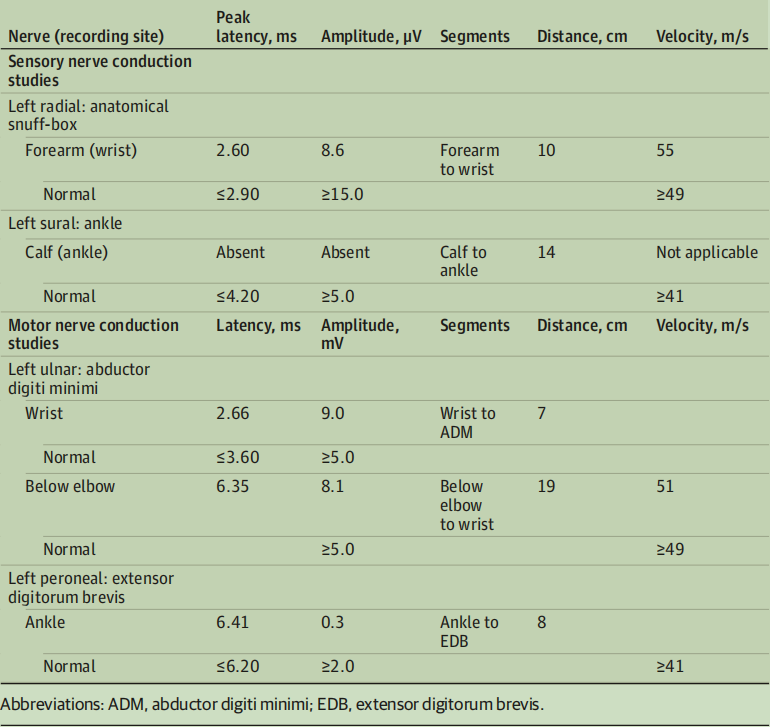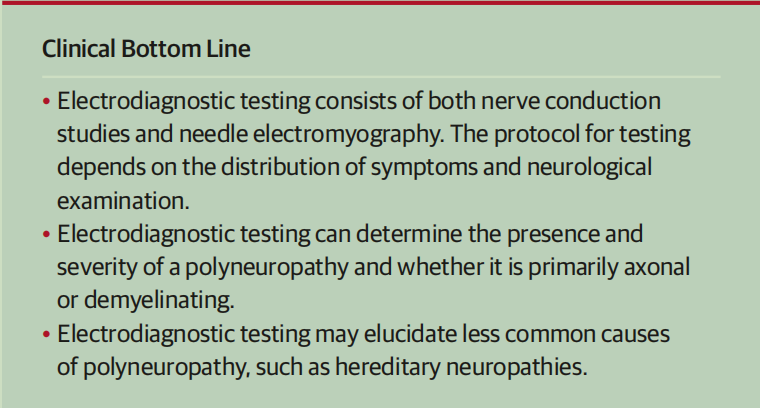Electrodiagnostic Testing for Diagnosing Polyneuropathy.pdf
A 50-year-old woman with a history of seizures presented to the electromyography laboratory with progressive lower extremity pain and gait imbalance for approximately 5 years. A neurological examination demonstrated reduced pinprick sensation in both feet and absent vibratory sensation at the first toes. Mild weak ness of ankle dorsiflexion and absent ankle jerk reflexes were noted bilaterally. She had a slightly wide-based gait, high-arched feet, andhammer toes. She had no known family history of polyneuropathy and no history of diabetes, alcohol misuse, known vitamin deficiency, hypothyroidism, or HIV. Nerve conduction studies (NCS) and needle electromyography (EMG) were performed. The results are shown in Table 1 and Table 2.
一个50岁的女人有癫痫病史到肌电图实验室检查,伴有进行性下肢疼痛和步态不平衡约 5 年。神经系统检查显示双脚针刺感减弱,第一脚趾无振动感。双侧踝关节背屈轻度无力和踝反射消失。她的步态略宽,足弓高,脚趾呈锤状。她没有已知的多发性神经病家族史,也没有糖尿病、酒精滥用、已知的维生素缺乏症、甲状腺功能减退症或 HIV 病史。进行了神经传导研究 (NCS) 和针状肌电图 (EMG)。结果见表1和表2。

Table 1. Sensory and Motor Nerve Conduction Study Results
表 1. 感觉和运动神经传导研究结果

Table 2. Needle Electromyography Test Results
表 2. 针头肌电图测试结果
Answer
回答
A. Results are consistent with axonal polyneuropathy
A.结果与轴索性多发性神经病一致
Test Characteristics
测试特性
Electrodiagnostic testing typically includes NCS and needle EMG. NCS involves application of an electrical stimulus to the skin above a nerve and use of surface electrodes to record wavefor mresponses from individual sensory and motor nerves. The action potential generated after electrical stimulation represents the number of fibers depolarized. The amplitude, distal latency, and conduction velocity of an action potential help distinguish whether a neuropathy is axonal or demyelinating. Needle EMG involves placement of a small recording needle electrode into a muscle to evaluate for abnormal insertional activity or spontaneous activity upon needle insertion and to assess voluntary motor units with volitional activation of the muscle. EMG can help distinguish neurogenic or myopathic weakness.
电诊断测试通常包括 NCS 和针状肌电图。NCS 涉及对神经上方的皮肤施加电刺激,并使用表面电极记录来自个体感觉和运动神经的波形响应。电刺激后产生的动作电位代表去极化的纤维数量。动作电位的幅度、远端潜伏期和传导速度有助于区分神经病变是轴突还是脱髓鞘。针 EMG 涉及将一个小的记录针电极放置到肌肉中,以评估异常插入活动或针插入时的自发活动,并通过肌肉的自主激活来评估自主运动单元。EMG 可以帮助区分神经源性或肌病性无力。
Definitive assessment of the sensitivity and specificity of NCS for detection of polyneuropathy is difficult due to the lack of a criterion standard. A study of 313 patients with confirmed polyneuropathy 1 to 6 years after NCS testing reported that surface sural NCS recordings had a sensitivity of 49% and specificity of 100%. Medicare reimbursement for electrodiag nostic testing, includingboth NCS and EMG, typically ranges from $190.48 to $371.26. However, the extent of electrodiagnostic testing depends on a patient’s distribution of symptoms, so costs may vary.
由于缺乏标准,很难对 NCS 检测多发性神经病的敏感性和特异性进行明确评估。一项针对 313 名在 NCS 测试后 1 至 6 年确诊的多发性神经病患者的研究报告称,腓肠表面 NCS 记录的敏感性为 49%,特异性为 100%。医疗保险报销的电子诊断测试,包括 NCS 和 EMG,通常在 190.48 美元到 371.26 美元之间。然而,电诊断测试的程度取决于患者的症状分布,因此成本可能会有所不同。
Application of Test Results to This Patient
将测试结果应用于该患者
Electrodiagnostic testing may be used to diagnose polyneuropathy, which is typically characterized by distal and symmetric abnormalities of sensory and motor nerve function. Polyneuropathy affects approximately 15% of individuals in the US older than 40 years, with diabetes being the most common cause. Electrodiagnostic testing can help delineate whether a neuropathy is axonal, which is characterized by direct injury to and loss of axons, or demyelinating, which involves damage to the myelin sheath surrounding nerve fibers. Axonal polyneuropathy typically results in lowamplitude or absent sensory or motor nerve responses on NCS findings, whereas demyelinating polyneuropathy presents with prolonged latencies or slowed conduction velocities. Certain abnormalities on needle EMG results in patients with polyneuropathy may suggest active or chronic denervation associated with the neuropathy. An EMG test may also be helpful to evaluatefor radiculopathy.
电诊断测试可用于诊断多发性神经病,其典型特征是感觉和运动神经功能的远端和对称异常。 在美国,大约 15% 的 40 岁以上的人患有多发性神经病,其中糖尿病是最常见的原因。电诊断测试可以帮助确定神经病变是轴突(其特征是轴突直接损伤和丢失)还是脱髓鞘(包括神经纤维周围的髓鞘受损)。轴索性多发性神经病通常会导致 NCS 表现的感觉或运动神经反应幅度低或缺失,而脱髓鞘性多发性神经病则表现为潜伏期延长或传导速度减慢。多发性神经病患者的针 EMG 结果的某些异常可能表明与神经病相关的活动性或慢性去神经支配。 EMG 测试也可能有助于评估神经根病。
Results of the NCS showed that the patient had an absent sural sensory response and decreased amplitudes of the peroneal motor and radial sensory responses (Table 1). These abnormalities are consistent with a severe sensory and motor polyneuropathy, characterized by axonal loss rather than demyelination, because the predominant abnormality is the low amplitude of the affected nerves rather than slowed conduction velocities. The patient’s polyneuropathy appeared length-dependent, meaning the nerve endings in the feet were affected before the hands, as shown by the results of sural sensory and peronealmotor studies being substantially more abnormal than the ulnar motor and radial sensory studies. Results of the needle EMG showed changes in voluntary motor unit morphology and a reduction in the recruitment pattern of the voluntary motor units in the first dorsal interosseous and tibialis anterior muscles, consistent with a severe degree of chronic reinnervation. The patient’s electrodiagnostic test findings, coupled with her abnormal foot appearance, raised the clinical suspicion for an underlying hereditary neuropathy.
NCS 的结果显示,患者没有腓肠感觉反应,腓骨运动和径向感觉反应幅度降低(表 1)。这些异常与严重的感觉和运动多发性神经病一致,其特征是轴突缺失而不是脱髓鞘,因为主要异常是受影响神经的低振幅而不是传导速度减慢。患者的多发性神经病似乎与长度有关,这意味着足部的神经末梢在手部之前受到影响,如腓肠感觉和腓骨运动研究的结果明显比尺骨运动和桡骨感觉研究更异常。针 EMG 的结果显示随意运动单位形态的变化和第一背侧骨间肌和胫骨前肌中随意运动单位的募集模式减少,与严重程度的慢性神经再支配一致。患者的电诊断检查结果,加上她异常的足部外观,引起了对潜在遗传性神经病的临床怀疑。
What Are Alternative Diagnostic Testing Approaches?
什么是替代诊断测试方法?
If the diagnosis of polyneuropathy is highly likely based on a patient’s medical history (eg, diabetes, chemotherapy exposure), electrodiagnostic testingmay not be necessary because itwill not change the clinical management. If Charcot-Marie-Tooth disease or another hereditary sensoryandmotor neuropathy is strongly suspected,a patient with polyneuropathy may directly undergo genetic testing instead of proceeding first with electrodiagnostic testing.
如果根据患者的病史(如糖尿病、化疗暴露)诊断多发性神经病的可能性很大,则可能不需要电诊断测试,因为它不会改变临床管理。如果强烈怀疑 Charcot-Marie-Tooth 病或其他遗传性感觉和运动神经病,多发性神经病患者可以直接进行基因检测,而不是先进行电诊断检测。
Patient Outcome
患者结局
Due to her severe axonal polyneuropathy and abnormal foot morphology in the absence of other common causes for polyneuropathy, genetic testing for Charcot-Marie-Tooth disease was performed, which revealed a pathogenic variant inMFN2 (Mitofusin 2). Variants in this gene are a common cause of axonal Charcot-MarieTooth disease and may result in a mild and late-onset presentation of sensory and motor neuropathy. Obtaining the diagnosis of Charcot-Marie-Tooth disease is important for appropriate genetic counseling, symptomatic treatment, and avoidance of additional, unnecessary tests.
由于她严重的轴索性多发性神经病和足部形态异常,且没有其他常见的多发性神经病原因,因此进行了 Charcot-Marie-Tooth 病的基因检测,结果显示 MFN2(线粒体融合素 2)的致病性变异。该基因的变异是轴突 Charcot-MarieTooth 病的常见原因,可能导致感觉和运动神经病的轻度和迟发性表现。获得 Charcot-Marie-Tooth 病的诊断对于适当的遗传咨询、对症治疗和避免额外的、不必要的检查很重要。
